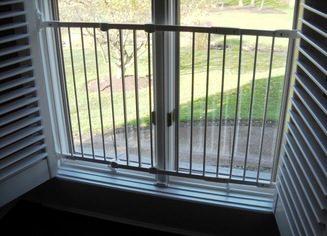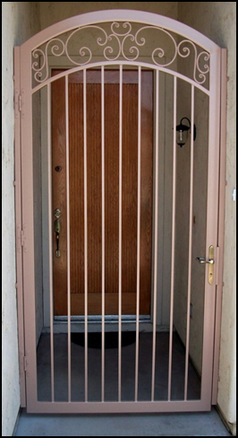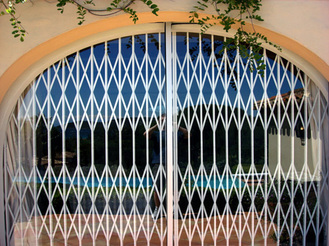STANDARD WINDOWGates and perimeter fencing are some of the most important
components of a well-designed self-storage site. In most cases, they are the first things your drive-by customer will see and, therefore, make an impression. When used correctly, they add beauty and attract the eye of anyone who passes by. Early planning is key to having the proper gate and fence layout. Care should be taken to ensure there is enough room for traffic to pull in off the street. This distance should include footage for a rental truck and other similar vehicles. In addition, 15 to 20 feet are necessary from the gate itself out to the keypad. Ideally, the office will be set back to allow for these distances. Parking should be available outside the fenced area for customers and new prospects.Leave space for the safe operation of the main property gate. |
Gate Types
There are four basic types of automated drive gates:
1. Barrier arms
2. Swing gates
3. Vertical-lift gates
4. Slide or roll gates
Of the four,barrier arms are the least likely to be used in self-storage. These are simply arm gates similar to those used for railroad crossings or parking garages. They can be made of wood or tubular steel. This style provides the least amount of security, and its cost is very similar to other automatic gates.
Swing gates are seldom used for self-storage. The number of cycles per day gives too much wear and tear on this style of gate. Traffic flow is also restricted because of the area needed to swing the gate back and forth.The length of a swing gate would be limited for this application due to the overall weight of the gate.
Vertical-lift gates pivot like an elbow on a table. They are counter-balanced, so they can be easily raised manually if necessary. This design is used when there are space limitations. When no area is available to roll a gate back, vertical gates are ideal. One of the advantages of the vertical-lift gate is it can come in a variety of sizes and shapes. A standard size for a self-storage facility is 16 feet. The length can be shorter or longer, but it is recommended that you not exceed 20 feet. Wind bracing is a must, especially for the longer gates.
Flexibility in shape is also beneficial. For example, if your driveway slopes from each side down toward the center, the gate could be made to follow the contour of the drive while remaining straight and level
across the top. Other designs can also be accomplished. The gate can be higher on one end than the other, allowing you to compensate for drives sloping toward or away from the operator. In a normal situation, the top and bottom of the gate will be level and parallel to the ground. When the gate is in its upright position, the width of the gate will be directly in front of the operator box; therefore, no part of the gate is extended into the driveway.
The most popular gate style is the slide or roll gate. Early installations had these gates on rollers on the ground. These days, a cantilever design is recommended. The cantilever gate has rollers that roll on a mid-rail attached to a fence section. This mid-rail supports the gate and allows it to open and close without touching the ground.
Slide gates require the space to roll the gate back from the drive along the fence line. The planning process should take the design intoconsideration. Sometimes the layout will require more than one gate location.Keep in mind this can drive the costs up. If a gate is only to be used for emergencies, a moving van, or a garbage truck, it may not need to be automated. Maintenance includes regular lubrication of the chain and a check of its tension.
1. Barrier arms
2. Swing gates
3. Vertical-lift gates
4. Slide or roll gates
Of the four,barrier arms are the least likely to be used in self-storage. These are simply arm gates similar to those used for railroad crossings or parking garages. They can be made of wood or tubular steel. This style provides the least amount of security, and its cost is very similar to other automatic gates.
Swing gates are seldom used for self-storage. The number of cycles per day gives too much wear and tear on this style of gate. Traffic flow is also restricted because of the area needed to swing the gate back and forth.The length of a swing gate would be limited for this application due to the overall weight of the gate.
Vertical-lift gates pivot like an elbow on a table. They are counter-balanced, so they can be easily raised manually if necessary. This design is used when there are space limitations. When no area is available to roll a gate back, vertical gates are ideal. One of the advantages of the vertical-lift gate is it can come in a variety of sizes and shapes. A standard size for a self-storage facility is 16 feet. The length can be shorter or longer, but it is recommended that you not exceed 20 feet. Wind bracing is a must, especially for the longer gates.
Flexibility in shape is also beneficial. For example, if your driveway slopes from each side down toward the center, the gate could be made to follow the contour of the drive while remaining straight and level
across the top. Other designs can also be accomplished. The gate can be higher on one end than the other, allowing you to compensate for drives sloping toward or away from the operator. In a normal situation, the top and bottom of the gate will be level and parallel to the ground. When the gate is in its upright position, the width of the gate will be directly in front of the operator box; therefore, no part of the gate is extended into the driveway.
The most popular gate style is the slide or roll gate. Early installations had these gates on rollers on the ground. These days, a cantilever design is recommended. The cantilever gate has rollers that roll on a mid-rail attached to a fence section. This mid-rail supports the gate and allows it to open and close without touching the ground.
Slide gates require the space to roll the gate back from the drive along the fence line. The planning process should take the design intoconsideration. Sometimes the layout will require more than one gate location.Keep in mind this can drive the costs up. If a gate is only to be used for emergencies, a moving van, or a garbage truck, it may not need to be automated. Maintenance includes regular lubrication of the chain and a check of its tension.



